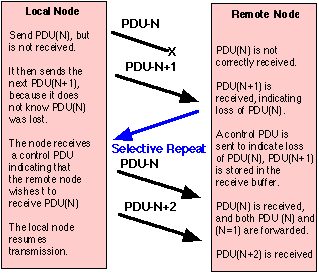
Selective Repeat error recovery is a procedure which is implemented in some communications protocols to provide reliability. It is the most complex of a set of procedures which may provide error recovery, it is however the most efficient scheme. Selective repeat is employed by the TCP transport protocol.
The above features are also required for Go-Back-N, however for selective repeat, the receiver must also maintain a buffer of frames which have been received, but not acknowledged.
The recovery of a corrupted PDU proceeds in four stages:

Retransmission using Selective Repeat
A remote node may request retransmission of corrupted PDUs by initiating Selective Repeat error recovery by sending a control PDU indicating the missing PDU. This allows the remote node to instruct the sending node where to retransmit the PDU which has not been received. The remote stores any out-of-sequence PDUs (i.e. which do not have the expected sequence number) until the retransmission is complete.
Upon receipt of a Selective Repeat control PDU (by the local node), the transmitter sends a single PDU from its buffer of unacknowledged PDUs. The transmitter then continues normal transmission of new PDUs until the PDUs are acknowledged or another selective repeat request is received.

Operation of Selective Repeat. The sender transmits four PDUs (1-4). The first PDU (1) is corrupted and not received. The receiver detects this when it receives PDU(2), which it stores in the receive buffer and requests a selective repeat of PDU(1). The sender responds to the request by sending PDU(1), and then continues sending PDUs (5-7). The receiver stores all subsequent out-of-sequence PDUs (3-4), until it receives PDU(1) correctly. The received PDU (1) and all stored PDUs (2-4) are then forwarded, followed by (5-7) as each of these is received in turn.
If the retransmission is not successful, the protocol relies upon a protocol timer in the local node to detect that no acknowledgment was received. The lost PDUs may then be recovered by Polling.
Comparison of ARQ Methods
The table below provides a comparison of the various ARQ methods described. (W is the window size, or number of PDUs which may be in transit at any one time).
| ARQ Method | Sender Buffer | Receiver Buffer | Control PDUs |
| Stop-and-Wait | 1 PDU | 1 PDU | ACK |
| Polling | W PDUs | 1 PDU | ACK, Poll, Response |
| Go-Back-N | W PDUs | 1 PDU | ACK, Go-Back-N |
| Selective Repeat | W PDUs | W PDUs | ACK, Selective Repeat |
See also